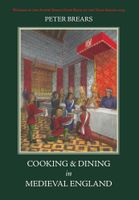Advertisement
The Pastry
Appears in
By Peter Brears
Published 2008
When reading medieval recipes for pastries, it soon becomes apparent that most were very different in character from anything we are familiar with today. Our pies and pasties are chiefly used to cook their raw fillings by a slow, enclosed simmering process, which involves keeping them in the oven for relatively long periods after their pastry has baked hard. As traditional pie-makers say, we don’t bake pies, we boil them, stressing that the important factor is the complete cooking of their contents. Even so, the crust has always to be crisp and palatable, since it forms an integral part of the experience of eating any pastry. In contrast, medieval pastry was essentially a mouldable substance in which very quickly-cooked delicate foods could be enclosed while being briefly baked in the oven. This meant that it had to be capable of holding its shape when merely dried, and it might be little more than half-baked when its custard, fish or pre-boiled meat fillings were fully cooked. This explains why the contemporary manners books make no mention of pastry as a food to be eaten; it was essentially the disposable cookware of polite society, although it was probably consumed by the poorer patrons of the urban pie-maker.

